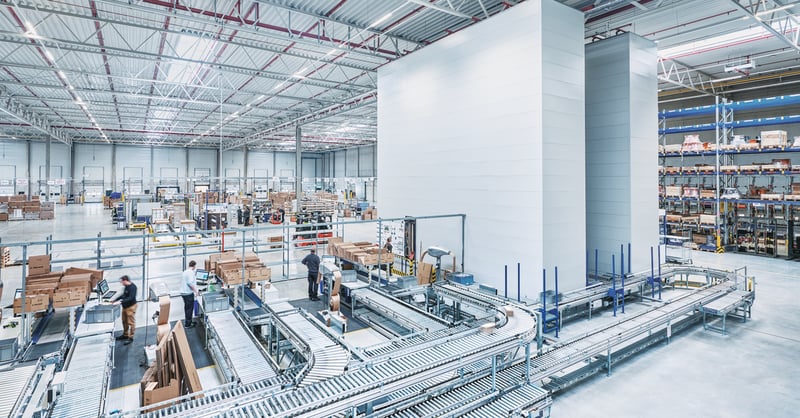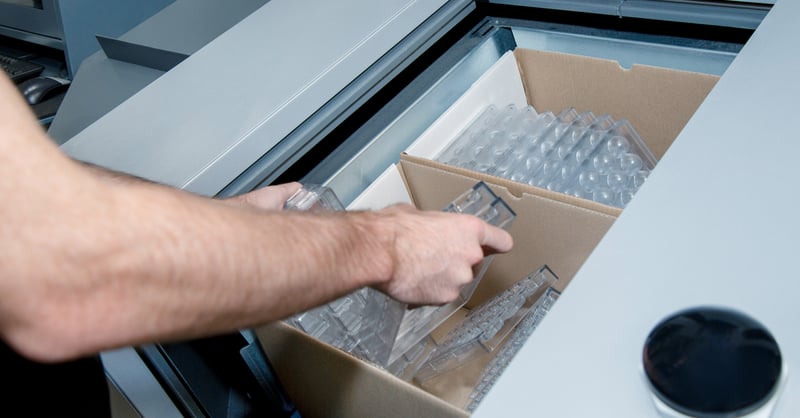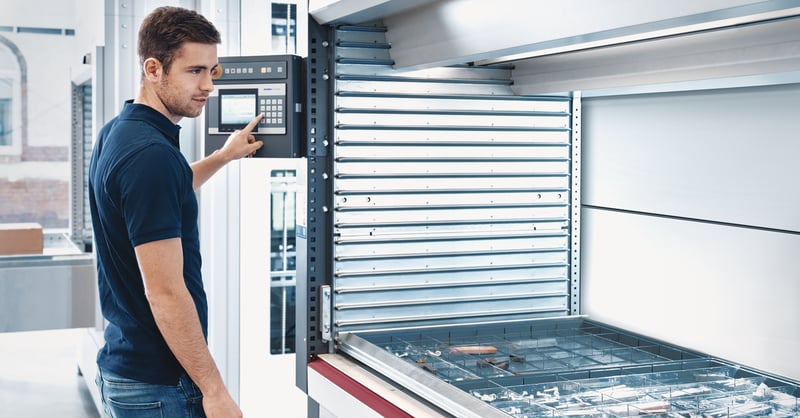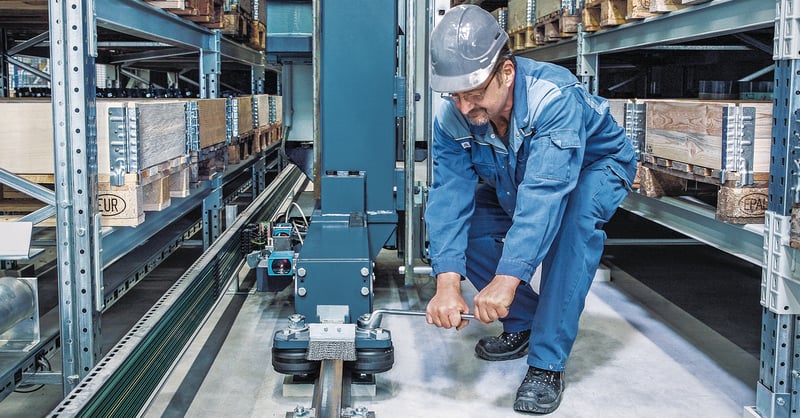Warehouse Layout
It can be daunting to even consider an overhaul on your warehouse layout. Organizing your space doesn’t have to start with a clean slate. It simply means you can optimize some of your current processes to help you and your staff complete day to day tasks more efficiently.
1. Organize Floor Plan for Optimum Process Flow
If you’re in the design phase of your warehouse, you’re in luck, because you can set things straight from the start. I know I said organization doesn’t have to start with an overhaul, and it doesn’t. This can be a long-term goal if you find things don’t flow in your warehouse in the best way for your business.
Now, take a step back and consider your current warehouse layout. An organized workspace should provide a safe environment for your employees and be highly efficient. The flow should be set up in the order of operations. For example, inventory comes in from Receiving and moves on to Storage either in one or multiple zones based on storage method. Once orders have been picked, they are packaged and sent to shipping and out the door.
Pro tip: get a pen and draw a line from where inventory comes into your facility, how it’s handled and how it leaves. You’re hoping for a relatively straight line.
Poll your staff who work in the space on a daily basis. Are there small corners of the warehouse which can be adjusted slightly to support their efforts? Enable your staff to speak up during this process improvement. Keeping your employees safe and happy is highly beneficial to their productivity and your overall success.
2. Stay Organized with Labels and Signage
This is an easy tip which you can implement immediately. Labeling inventory and work zones throughout your warehouse will ensure organization and facility flow is maintained long term. Once you’ve established your warehouse layout, labels will ensure employees know where to find things and/or where they belong. This can be especially beneficial for new employees or in facilities that utilize temp labor often.
Don’t stop at your inventory and work zones. Consider adding signage to any hazards or ceiling restrictions to ensure employee safety. Replace labels and signage regularly, as needed, to reduce errors or misplacing valuable inventory.
3. Provide Maps
Help your employees navigate the warehouse by providing maps. While labels and signage clearly communicate what they need to know, maps can be especially beneficial for new or seasonal employees with less experience in the facility. The faster people get to where they need to go, the quicker they get the job done.
4. Review Storage Capacity
Now that everything has a home and is clearly labeled, it’s time to review your storage capacity, which is the maximum amount something can hold. Using simple math, multiply height x width x depth = storage capacity, in cubic feet. If you’ve opted for traditional rack and shelving in your warehouse, how are the shelves spaced out? Are they evenly spaced, leaving room at the top of your products? If so, you’re paying to store air! Learn more about how you can maximize your storage capacity by implementing automated storage methods.
 |
“A lot of companies are maximizing their vertical space by implementing automated storage and retrieval systems, allowing them to save space and expand operations in their current building without the need for relocation. It’s a win-win situation that overcomes space constraints while boosting productivity." Mark Dunaway President - Americas |
Inventory Management
Inventory management accounts for just about everything physically in your warehouse. Without a system in place to keep track of your assets, it can be difficult for your employees to do their jobs. Categorizing inventory and using proper storage methods maximizes your existing facility and frees up previously wasted space to increase capacity and improve efficiencies.
5. Classify Inventory
Start by classifying your inventory to ensure you’re organizing even your slowest moving items accordingly. Profiling your stock keeping units or SKUs should be supported by data. Take inventory of what is currently in your warehouse (size, shape, quantity) and how often it moves or frequency of picking. This will help you organize your inventory into categories: A, B, C and D also known as your fast (A), medium (B), slow (C) and very slow (D) movers. Once this is charted (see below), cross reference your documented SKU velocity with the amount of time it takes to pick those items, this will tell you how much it costs to pick your inventory.
If you apply the Pareto Principle (80/20 rule) here, you could imagine it makes the most sense to focus on the 20% of your inventory being picked 80% of the time. If that’s the case, you’d be missing the improvement opportunity from the remaining 80% of your inventory which sits stagnant more often than not. Take a closer look at SKU profiling and classifying your inventory.
6. Compartmentalize Inventory with Totes, Bins and Dividers
Storage devices make me happy because they promote organization of even the smallest items. Whether you need to store nuts and bolts or pre-assembled kits, I can guarantee there is a tote or bin to keep your items in order. Add labels and you just earned yourself a gold star! There are so many companies selling totes…for a living. Crazy, right? Our expertise is in automated storage and retrieval systems (ASRS) but we’ve expanded into the realm of storage boxes designed specifically for our technologies. Read more about totes, bins and dividers and why they are important.

7. Implement a Slotting Strategy
I don’t recommend trying to slot your inventory until after you’ve classified, compartmentalized and labeled it. Slotting can’t be done without data. To increase employee picking productivity, slot your inventory first by velocity. Since you’ve already classified your inventory, you know what your fast and medium movers (A and B movers) are versus your slow to very slow movers (C and D movers). Slot your fast and medium movers in the area or zone with the easiest access. Your slow and very slow movers can find their place further away from the shipping area for example without suffering a dip in productivity. Your employees will thank you if you reduce their walking distances from fast and medium movers to the shipping zone.
Next, slot your SKUs by zone or technology. You’ll need the information about inventory size, shape and weight here. Sometimes there are limitations based on what you need to store and what storage methods you’re using. Read more about slotting inventory by zone/technology.
8. Implement an Efficient Receiving Process
Do you have boxes piling up next to the receiving door? This screams disorganized warehouse to me! Review your process for receiving inventory. The inventory coming in the door is just as important as the inventory you’re shipping out. Designate an employee to manage receiving as they will be your quality gate. Did you receive the correct quantity and was the shipment in good condition? They should process the shipment accordingly and immediately store the items in your perfectly labeled storage systems.
9. Document Your Returns Handling Procedures
In addition to your receiving process, don’t forget to factor in the returns handling process. While this might be covered with receiving, outline all of the steps for employees to ensure returns are taken care of appropriately. If returns go missing, this is money out of your pocket. Keep your warehouse efficient with a documented process. Learn more about returns handling procedures.

|
"Managing e-commerce returns is a persistent challenge for modern supply chains, demanding significant resources. Leveraging automation for returns is a game changer. Developing an automated reverse logistics strategy is crucial for maintaining stability during peak periods, ensuring quick restocking of items, optimizing inventory, and delivering cost savings throughout the supply chain. " Christina Dube Marketing Director - Americas |
10. Automate Storage for Maximum Capacity (Assess Storage Methods)
Tell me about your warehouse. Are you using traditional racks and shelving…automation…or a combination of the two? This is a judgement free zone. I understand there are benefits and limitations to all storage methods. Obviously, I’m a little biased.
There are plenty of storage methods to choose from. It’s important to talk to an expert to determine if there’s opportunity to improve what you’re already working with. I will tell you, ASRS will protect your inventory from damage and theft. Utilizing the vertical height in your facility, ASRS maximizes storage capacity in 85% less floor space. Operating on the goods-to-person principle, ASRS delivers items directly to an operator at an ergonomic workstation with the touch of a button. Read more on the different types of ASRS technologies on the market.
Want more? Learn about automated storage and warehouse organization live and in person at the ProMat tradeshow in Chicago! Learn more about the bi-annual event here.
11. Lean Your Inventory
Lean your inventory to align with just in time (JIT) practices. When there is less inventory on hand, there is less to organize. Only keep what is essential to prevent overstocking inventory. Of course, it can be helpful to have some safety just in case stock on hand but use data to determine the appropriate quantities. This will keep your warehouse operating at high efficiency and deliver the service your customers expect. Learn more about JIT inventory management vs JIC inventory management.
 |
“With delivery expectations rising, 'just-in-time' isn’t enough anymore, while ‘just-in-case’ can be too much. We’re seeing shit to blending these two inventory strategies to stay cost effective, yet insulated against supply chain disruptions. Automated storage solutions are a big help with this, letting warehouses hold more inventory on hand as needed without compromising on space or efficiency.” Cal Bowers Sr. Director of New Business |
12. Organize Safety Stock
Don’t forget to leave room for safety stock. This is extra inventory you have on hand in buffer storage to avoid shortages. To ensure you always have adequate inventory levels to accommodate unpredictable spikes, designate a location for this safety stock. This reduces the likelihood of inventory being misplaced.
13. Implement Cycle Counting
No one likes big year end physical inventory. Keep track of your inventory regularly with cycle counting. Whether you cycle count weekly, monthly or even quarterly, if you keep track of your inventory throughout the year you can eliminate the need for a costly year end inventory count. This helps you maintain accurate inventory levels and supports your organization practices on a continuous basis.
14. Adopt a Warehouse Management System
Warehouse Management Systems (WMS) provide to support many of these warehouse organization ideas. With data from your WMS, you can properly classify and slot inventory, determine proper storage methods, track inventory movement and more. The sooner you implement a WMS the more access you’ll have to this information going forward and historically over time which optimizes the functionality of your warehouse.
Maintaining an organized warehouse requires visibility into real-time inventory tracking, which a WMS provides. From inventory levels and locations to SKU movement and operator statistics, a WMS can provide insight to support your business objectives.
Clean Workspaces
Don’t let all of your hard work organizing your warehouse go to waste by taking the “set it and forget it” approach. A clean workspace prevents damage to inventory and increases productivity. It keeps your employees healthy too. Routine cleaning procedures will ensure your warehouse operates at maximum efficiency.
15. Clean Regularly
Whether you create a checklist for your employees to execute at the end of their shift, for example, sweeping, cleaning work surfaces, etc. or you hire a service to clean your facility, don’t forget this step. Keeping the warehouse clean from dust and dirt or larger hazards such as spills ensures employee safety. This will also prevent damage to your inventory or potential loss of product.
16. Train Staff to Maintain Organization
Once you’ve updated your disorganized warehouse to a new and improved facility, train your staff to maintain it. Set expectations and regularly check in with your employees to ensure the new layout is sustainable. The labels, signage and maps you’ve created will support this process.
17. Perform Regular Maintenance
It’s in your best interest to adhere to the manufacturers maintenance schedules they recommend. Make the maintenance of your equipment a priority. It keeps your facility in working order reducing or eliminating unplanned downtime. When your equipment works properly, your employees can remain productive. Often, purchasing the extended warranty for maintenance on your equipment is worth the investment.

|
"Prioritizing regular machine maintenance not only keeps your facility running smoothly but also prevents costly unplanned downtime. When equipment operates as it should, employees can stay focused and productive. Investing in an extended warranty for maintenance pays off in the long run—it’s a smart way to protect both your equipment and your bottom line." Nate St. Pierre Director of Service - Americas |
18. Keep Aisles clear for Moving Vehicles
Even an organized warehouse has a lot of moving parts. Keep aisles free and clear for moving vehicles such as forklifts to keep employees and equipment safe. Optimize aisle space for forklifts to travel easily without giving them too much room, wasting valuable floor space. Reducing clutter also allows for easy access to stored SKUs.
In Review...
This is a lot to review, so let me remind you to start small. Pick one or two things which you can implement immediately for the quickest return. The most important thing to keep in mind after organizing your warehouse is to review your processes and procedures regularly. Did your changes have a positive impact? Are your employees more efficient? When it comes to facility flow or labels and signage, small adjustments can make a world of a difference. Organizing your warehouse today will set you up for an efficient and successful business today and in the future!
Prepare for 2025 with these 25 Expert Insights on Warehouse Automation Trends coming your way.






